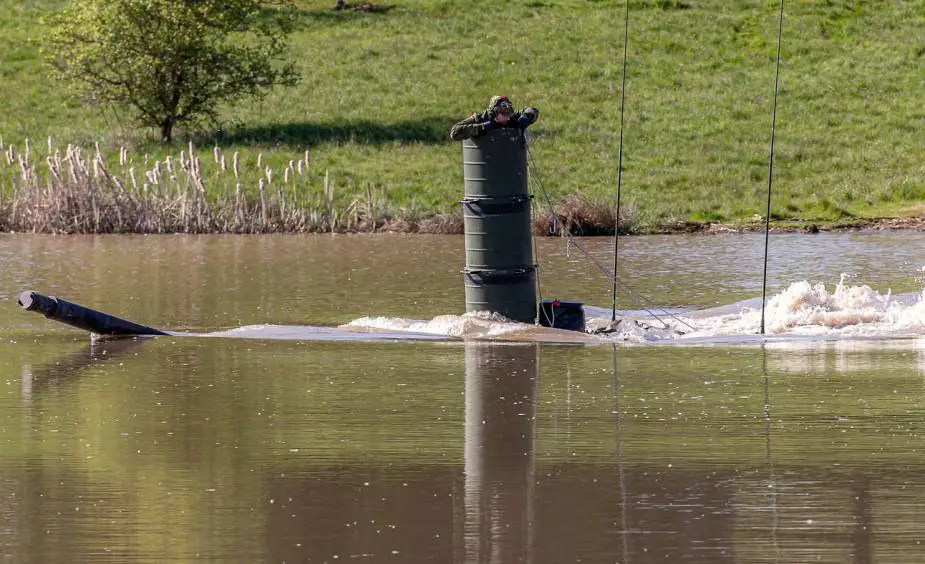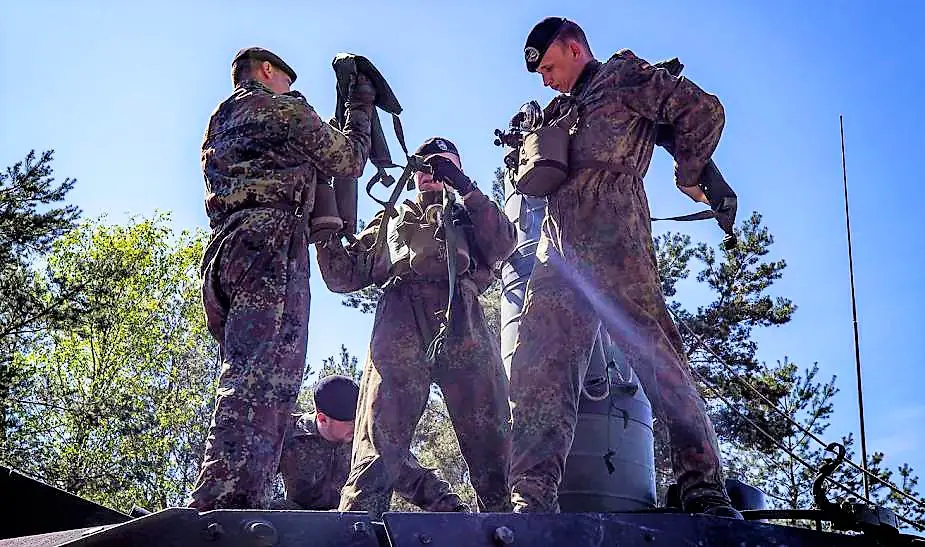The combat duty with the main battle tank is routine for the soldiers of the Panzer Battalion 393 from Bad Frankenhausen. However, even for experienced crews, this training is not an everyday occurrence: on the training ground in Bad Salzungen, they are training for the first time to drive the Leopard 2 A7V through a water obstacle. Can the nearly 64-ton heavy tank make the journey below the water's surface? The Bundeswehr reports.
Follow Army Recognition on Google News at this link

In Bad Salzungen, tank crews from German Army’s Tank Battalion 393 practice underwater driving with their Leopard 2 A7V main battle tank (Picture source: Bundeswehr/Mario Bähr)
Tension is in the air as a Leopard 2 A7V tank drives out of cover and heads downhill towards the shore of a lake. It has an oddly shaped tower mounted on top, from which the vehicle's commander looks out. Within seconds, the Leopard is in the water and barely visible. How does it work? Will the tank hold up?
We are at the training ground in Bad Salzungen. Today, every 25 minutes, tanks drive through a reservoir that looks like a river section from above. Here, the soldiers practice driving their combat vehicles underwater. This is used in tactical situations when engineer forces are not available to cross a specific location, and driving through the water is possible and tactically necessary. This allows the armored unit to continue its mission promptly.
Back in cover, the tank crews take up position with their combat vehicles, positioning themselves in a covered location in the undergrowth near the reservoir. They have received additional equipment for the underwater journey, which is not always on board the tanks but is usually carried by support forces for emergencies. This includes the turret extension, as well as breathing apparatus and life jackets for the crews. Breathing apparatus is also called oxygen self-rescuers, small breathing apparatuses with pressurized oxygen.

After several rehearsals, soldiers become more comfortable with using the breathing apparatus and the exit procedure (Picture source: Bundeswehr/Mario Bähr)
Complex preparation
What is not immediately apparent is that before the tank enters the water, preparation is necessary, without which no Leopard can cross a body of water deeper than two meters. And it takes time. The four soldiers on the tank go through a detailed checklist according to regulations. It includes everything related to underwater driving. This includes checking the central hydraulic system, which seals the tank completely. The engine air intake, which is located at the back of every Leopard 2, also stops working so that the engine does not draw in water. If the soldiers make a mistake, it could be dangerous for the crew.
The ‘’tower’’(a tube forming a turret extension) fitted on the tank commander’s hatch is where the commander sits during the water crossing. Underwater, it is the only connection between the tank's interior and the air. The special feature: The engine is also supplied with fresh air during the journey through this structure. Its draft can be felt on the commander's seat. The tube is made of aluminum, stable but not bulletproof and not expandable. It is tightened during preparation with a torque wrench. A safety device then prevents the commander's hatch from closing accidentally and the 1,500-horsepower engine from emptying the entire combat area air within seconds. This is a big danger for the crew: the sudden lack of oxygen would immediately lead to the suffocation of the soldiers. To prevent this from happening, a safety device would shut down the engine within one second in an emergency.
The periscope, the tank's sensitive and precise optic, is also protected by a diving cap from dirt, debris, and damage, such as floating debris. The 120mm cannon is maximally tilted upwards. It and the aperture for the machine gun are additionally sealed with a cap. The fan, which otherwise sucks in the fine dust created by the machine gun shots, is closed. Also, the protective grille inside between the commander and the loader is removed in advance to free the escape route.
Not every combat vehicle of the German armed forces has the ability to travel underwater. Some can only wade through shallow waters of a few decimeters, while others are able to swim. Certain models of the Fuchs transport tank have this capability, while the Leopard tank cannot swim due to its weight of almost 64 tons, and must move along the bottom of the waterway. Once the signal to enter the water is given, the tank immediately descends towards the bottom and becomes as quiet as a sailing boat.
The Leopard 2 A7V can cross waterways up to 4 meters deep, even in currents. The Thuringian reservoir is an artificial waterway with a solid base, and its depth is just over 3 meters. Once the tank is fully submerged, only the muzzle of the cannon and the diving hatch with the commander are visible. At 4 meters deep, almost the entire diving tube and the cannon are underwater, with the latter tilted to prevent it from touching the bottom or shoreline during steep entry or exit, and to provide more space for the crew to quickly leave the tank in case of emergency.
The driver must maintain a specific engine speed in a designated gear to avoid getting stuck in the muddy riverbed. The tank must keep moving, and the driver has no external visibility during the journey, relying on the commander's instructions.
In case of an emergency, the crew must rapidly and calmly exit the tank to avoid drowning, following a strict emergency procedure that is extensively drilled in advance. For example, soldiers must find their way out of the interior of the tank blindfolded during training. The entire crew can exit the vehicle in just 50 seconds, and this helps build confidence and trust among the crew, as well as in the tank's equipment. The aim is to ensure that everything functions as practiced in an emergency.
Complications are extremely rare, but unexpected deep mud may require even deeper diving, and there is a risk of the tank tipping over in strong currents on soft ground.
What to do if the tank fills with water within a few seconds? The interior quickly becomes dark due to the muddy river water. The commander must leave the diving hatch first to make room for the others. The loader, gunner, and driver must exit the tank via the diving hatch over the tank turret.
A prepared breathing apparatus must be put on within seconds, and the soldiers must move through the inside of the tank while breathing through the apparatus, which enriches exhaled air with oxygen and enables underwater breathing for up to 90 minutes. The soldiers must remain calm and follow each step to exit the tank.
The exit procedure is a challenge even during training, such as learning the proper use of the breathing apparatus. The soldiers must show that they can perform the procedure without stress during extended swimming training with a test. At first, many soldiers may feel uneasy about the situation, especially if the tank is not completely watertight and a few drops of water enter. However, after several rehearsals, soldiers become more comfortable with using the breathing apparatus and the exit procedure. The crews know their tanks inside and out, which increases their confidence in the equipment and themselves.

The Leopard 2 A7V can cross waterways up to 4 meters deep, even in currents (Picture source: Bundeswehr/Mario Bähr)
Trust in oneself and technology
In training, getting out of a vehicle (known as "ausbooten" or "aussteigen" in German) can be a challenge, particularly when it comes to handling the breathing regulator or emergency breathing apparatus. Soldiers learn this during extensive swimming training with testing. They must demonstrate that they can carry out procedures without stress. At the beginning, many soldiers are apprehensive, especially when the tank is not entirely waterproof and a few drops of water enter. However, after practicing breathing with the apparatus and exiting several times, this fear dissipates. The crew knows their tank inside and out. This training further instills trust in both technology and themselves.
As soon as the tank leaves the water, it quickly moves to the nearest cover, and the crew restores full combat readiness. The tank only spends about a minute crossing the approximately 100-meter-wide water obstacle. However, the organizational effort required for a week of training, which runs parallel to this year's NATO Very High Readiness Joint Task Force (VJTF) exercises, is enormous and time-consuming. "This exercise is still a good change of pace for us from normal combat duty. In this way, we return to basics and pass on our knowledge to both new and experienced comrades, giving them the opportunity to refresh and expand their skills," explains one soldier. On-site, this security is additionally reinforced by the engineer corps with a recovery vehicle and by regional support forces. The exercise was supported by police divers and the internal water rescue group of the German Red Cross in South Thuringia."
Defense News May 2023















